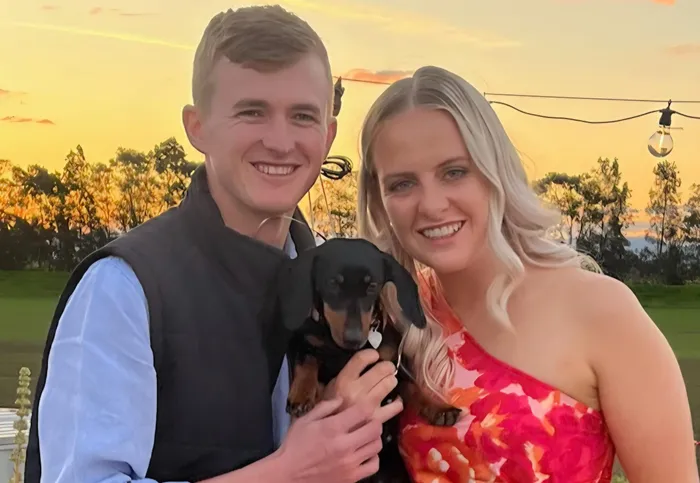
Josh Fishlock and Georgia Gardner with Valerie.
Image: Georgia Gardner
Jonathan Edwards, Victoria Craw
For 528 days, Valerie the miniature dachshund survived in the Australian wilderness by eating roadkill, evading venomous snakes and eluding the grasp of humans who wanted to rescue her. All the while, her owners worried about whether they would see her again.
Then came Day 529.
“Valerie, has been safely rescued and is fit and well,” Kangala Wildlife Rescue said last Friday on its TikTok page. “We are absolutely thrilled and deeply relieved that Valerie is finally safe and able to begin her transition back to her loving parents.”
Valerie’s capture ended an odyssey that started in November 2023, when she escaped during a family camping trip to Kangaroo Island, a rugged island off the southern Australian coast. Her owners’ panicked search proved fruitless, even when the nonprofit wildlife rescue helped by setting out food, surveillance cameras and her owners’ clothing to try to lure her back to safety and comfort.
Nothing worked.
Days turned to weeks. Weeks turned to months. Hope faded that the eight-pound “absolute princess” who was “anxiously attached” to her owners would be found alive.
“We were so upset, and we felt a lot of guilt as well,” Georgia Gardner, whose family had gifted her the dog after she graduated from college during the coronavirus pandemic, told The Washington Post last month.
Gardner and her boyfriend, Joshua Fishlock, had left Valerie in a playpen stocked with toys and food at their campsite to go fishing at a beach. But she tore through the pen and escaped. When other campers tried to retrieve her from underneath a parked car, she got spooked and bolted into the bushland.
Six to eight months later, rescuers started hearing from island locals about a wandering dog with a pink collar. Kangala Wildlife Rescue Director Jared Karran, who led the search for Valerie, was shocked, calling the reports “unbelievable” because miniature dachshunds typically don’t have strong survival skills.
“Of all dogs, that would be the last one I would say would survive out there, but they do have a really good sense of smell,” Karran previously told The Post. “That’s probably helped her in terms of finding food.”
Karran said Valerie also would have had to evade two species of venomous snakes that live on the island: Pygmy Copperheads and Black Tiger snakes.
But proving Valerie was alive and catching her were two different things. Life in the bush had made her cautious. She bolted at the sight of people or their vehicles. Even locals found her “impossible to catch,” the rescue said.
Karran marveled at Valerie’s transformation from spoiled pet to rugged survivor.
“She’s so fast and so wary now,” he said last month.
Rescuers’ hopes rose from late February through March with some local sightings and a photo of a small black dog running across a field. They homed in on Valerie, narrowing her location to the Stokes Bay area, near where she went missing. The rescuers tried to entice her with tuna and roast chicken.
“Hopefully we can pull this off and actually get her home,” Karran said in late March.
Kangala set up a trap cage filled with food, Gardner’s clothes and Valerie’s old toys and bed from home. On April 14, the wildlife rescue said Valerie had repeatedly used the cage.
But rescuers hadn’t captured her because of the dog’s irregular visitations, which sometimes were five or six days apart. Volunteers who had camped out near the cage reported hearing her barks - some of them quite close - although sightings were rare.
“Valerie is like the Dachshund version of Big foot!” the rescue said.
But on Friday, the group posted news of her capture alongside trail-cam footage of her chomping on food inside the cage, looking into the camera and seemingly giving it a “cheeky wink.”
Kangala Wildlife Rescue volunteers spent more than 1 000 hours and travelled about 5 000 kilometers trying to catch Valerie, the nonprofit said.
About a week before her capture, her owners posted a montage of videos of her from 2023 - before her grand adventure. The clips show her getting belly rubs, reaching up to bite a tennis ball in someone’s hand, sleeping under the covers, napping on a sun-speckled couch and getting more belly rubs.
The wildlife rescue said it is working on giving her back to Gardner and Fishlock so she can transition from the life of a gritty survivor back into a pet princess. | Washington Post